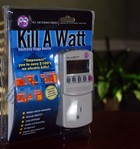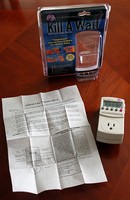 I was recently given a Kill A Watt electricity usage monitor, so this weekend I decided to try it out.
I was recently given a Kill A Watt electricity usage monitor, so this weekend I decided to try it out.
I’ve always wondered how much energy we’re wasting in our home. And if there’s a way to save money on electric bills, then I’m all for it!
Plus, we’ve been trying to be more ‘green’ these days. Maybe this fun-looking little gadget will help.
Empower Me, Baby!
Okay, so this is what the official website for the Kill A Watt looks like.
And that is exactly what the product’s packaging looks like… word for word.
But I still can’t exactly figure out what to do with this product once you take it out of the pretty packaging. Nowhere does it say HOW to use the Kill A Watt electricity usage monitor. And, the instructions are just product specs rather than how-to instructions.
I guess I’m on my own with this one…
Experimenting With The Kill A Watt
So I went to the outlet nearest to me that had something in it: the bathroom nightlight.
I removed the night light and plugged the Kill A Watt in instead. Immediately, it registered the following:
- 123.1 Volt
- 0.00 amp
- 00 watt
- 59.9 hz
- 0.00 khw
…whatever that means.
Then, I plugged the night light into the Kill A Watt itself, and it registered the following:
- 123.1 Volt
- 0.00 Amp
- 00 Watt
- 59.9 Hz
- 0.00 Khw
…Same numbers. Whatever that means.
Next, I plugged the Kill A Watt into a different outlet. Obviously, I got the same readings as above. But then, when I plugged my laptop (that was ‘on’… not in standby mode) into the Kill A Watt, I got the following readings:
- 121.7 Volt
- .27 Amp
- 18 Watt
- 59.9 Hz
- 0.00 Khw
Okay, now we’re getting somewhere. At this point, I’m thinking, ‘Amps and Watts! Those must be the ones that I’m supposed to be paying attention to here.’
But nowhere does it say what’s ‘bad’ and what’s ‘good’ in terms of amps and watts. So I don’t know what those numbers mean! And what am I supposed to do with those numbers?
But Wait, There’s More!
A few hours later in the day, I realized there were some extra letters underneath a few of the buttons on the Kill A Watt meter, so I decided to recheck my laptop computer numbers and push the buttons a few times to ‘toggle’ to those other levels. (The instructions don’t address this.)
Here are the numbers I got for my laptop this time:
- 121.2 Volt
- .74 Amp
- 44 Watt
- 88 VA
- 59.9 Hz
- .49 Pf
- 0.00 Khw
- 00:05 Hour (that one, I’m pretty sure is simply ‘elapsed time’… 5 minutes)
Next, I decided to check out the readings on our 42″ flat screen TV. First, in standby mode:
- 122.2 Volt
- 0.04 Amp
- 01 Watt
- 04 VA
- 59.9 Hz
- .19 Pf
- 0.00 Khw
- 00:03 Hour
Then, with the TV on:
- 121.2 Volt
- 2.21 Amp
- 196 Watt
- 270 VA
- 59.9 Hz
- .72 Pf
- 0.00 Khw
- 00:04 Hour
At this point, I’m pretty much just getting more frustrated because I don’t know what to do with all these numbers I’m getting. A ‘fun’ gadget?… I’m not so sure.
It Works Straight Out Of The Box… Kind Of
 My frustration stems from the fact that I’m starting to feel really stupid. This product is insulting my intelligence. Perhaps I’m barely smarter than a cardboard box when it comes to ‘green’ gadgets. I’ll admit it… we haven’t been trying to go green for long. We’re just beginning to dabble in energy-efficiency and ways to protect the environment.
My frustration stems from the fact that I’m starting to feel really stupid. This product is insulting my intelligence. Perhaps I’m barely smarter than a cardboard box when it comes to ‘green’ gadgets. I’ll admit it… we haven’t been trying to go green for long. We’re just beginning to dabble in energy-efficiency and ways to protect the environment.
But I’m usually pretty tech savvy when it comes to things like computers, digital cameras, cellphones, GPS navigation systems, etc. And I can work the high-powered multi-product home stereo system that we have (Jim, on the other hand, cannot). So I’m not an idiot with this kind of stuff.
But this little no-frills Kill A Watt gadget has got me beat. There are no bells & whistles. There is no WOW factor. The instructions leave much to be desired. And there are no points of reference to compare the numbers you receive on the Kill A Watt with the numbers you should be receiving — in order to have an energy-efficient product. (Or whatever you’re supposed to be learning from this gadget… the instructions don’t really say.)
Well, actually the fancy product packaging says:
- Empowers you to save $100’s on electric bills!
- Monitors electric consumption
- Accurate within 0.2%
- Large LCD display
- Enables cost forecasting
- ETL Approved
- Displays 8 critical units of measurement
Aside from the product itself leaving much to be desired, I think the packaging is a classic example of engineers designing the Kill A Watt packaging, rather than focus groups or product marketing experts. I mean, it all sounds good, but what does all of that really mean?! I mean, I just want to save a few bucks on my electric bills if possible — while educating myself about any power that I may be wasting. But c’mon… I need a point of reference to know if I’m being wasteful or not!
I’m trying to go green… but I guess I need more help than the Kill A Watt provides right out of the box.
UPDATE: Here are 2 green living articles with helpful tips for getting the most from the Kill A Watt gadget:
What Others Are Saying About The Kill A Watt
For the record, lots of other people are writing about the Kill A Watt electricity usage monitor. But they’re not really saying much more than the product packaging itself does. For some reason, this product is definitely on the radar of the most popular gadget-friendly sites. Maybe because it only costs about $20 or so and everyone’s looking for fun new gadgets that help you go green these days.
Here are the best reviews I could find for the Kill A Watt product.
Finally, just as I’d about exhausted my search for how to make this product work, I found Ross Olson‘s site. While I’m embarrassed to say that his info is still over my head a bit, at least he included some how-to’s and reference points:
Home Power magazine (Issue 90, Page 116). It got a great review in the ‘Things That Work!’ column for being just right for enthusiasts, if not professionals.
Well, I’m certainly not an enthusiast, nor a professional. I’m just an average everyday consumer, and I’d love to hear if other average people like me have managed to make this product work.
Here’s one of the most practical and honest reviews of the Kill A Watt I’ve found to date. It’s starting to make a bit more sense now. But still… waaaaayyy too much math. I checked out pretty early on this one.
A Few Other Downsides…
By the way, I can’t help but notice that the Kill A Watt really can’t measure the electricity used to power things like your stove, clothes dryer, hot water tank, and air conditioner — because they all run on 220 volts, and the Kill A Watt only works with 110 volt outlets. Yet, those are some of the largest energy hogs in a home, from what I understand. Oh well, doesn’t really matter… I wouldn’t know what I’d do with those numbers either.
Jim says you’re supposed to take all the numbers you get from the Kill A Watt and compare them with your monthly electric bill in an attempt to itemize how your monthly energy usage breaks down. Really? Again, too much math for me and a bit too much work when I thought this handy gadget was going to do all the hard work for me.
I guess for me — in these very early stages of going green — it is what it is. I mean, my laptop computer uses what it does. But I’m certainly not going to stop using it. Same with the TV. I mean, we already bought these products. What are people supposed to do?… Return them if their numbers are too high? (As if I knew what ‘too high’ really meant.)
Oh, and did I mention that you have out unplug everything else that’s in the wall socket outlet in order to plug the Kill A Watt in to use it. Yep, this little gadget takes up the whole space, regardless of whether you plug it into the top outlet or the bottom one.
Overall, I’m sure the Kill A Watt will be beneficial to some. Probably the ‘professionals and enthusiasts’ mentioned above. Perhaps I’ll revisit this product later as we progress in our efforts to live green.
Peace.
More Energy-Saving Tips & Ideas
- Striving for Efficiency
- 100 Ways To Save Energy At Home
- Free Carbon Footprint Calculator
- Tips For Reducing Your Carbon Footprint & Energy Use
- Professional Home Energy Audits
- DIY Home Energy Audit
- How To Have A $60 Electric Bill With A 2,200 SF House
Always on the lookout for a good bargain, I consider myself a frugal person — but not cheap. And not afraid to spend money on the things that matter. I like to share good deals with others when I find them. One of my favorite ways to save money is to reuse items in ways other than their intended purpose — so I write a lot about outside-the-box ideas that most people wouldn't think of! When I'm not saving money or looking for good deals, you'll find me at the corner of Good News & Fun Times as publisher of The Fun Times Guide (32 fun & helpful websites).








